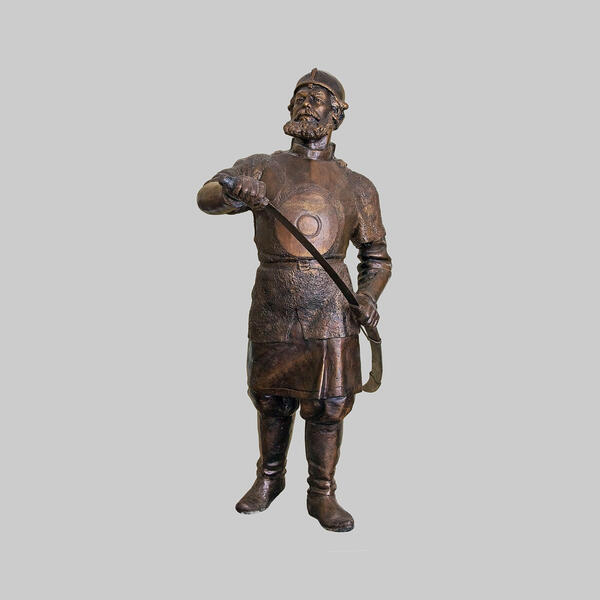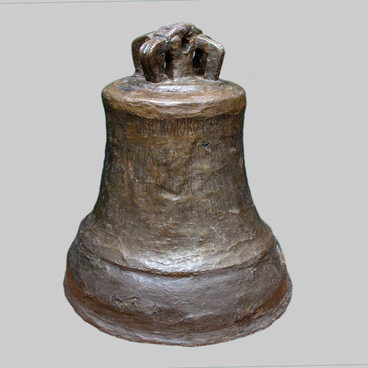Traditionally, Yermak is called the conqueror of Siberia. Yermak had served the Stroganov merchants from 1579, protecting their possessions from the Siberian Tatars, and then led an expedition through the Ural mountains. It was he who defeated the Khan’s army and occupied the capital of the khanate - Kashlyk, even though the enemy’s forces were significantly superior to his own. After the victory, Yermak sent an ambassador to Ivan the Terrible with a request to accept Siberia under his rule, and the ataman was generously rewarded. A military expedition under his command allowed to begin joining a vast territory beyond the Urals to the Muscovy, and as a result, Russia’s borders expanded to the shores of the Pacific ocean.
There are many works associated with this legendary figure in the collections of paintings and sculptures of the Tobolsk Museum Reserve. It is possible to name the sculpture of Alexey Ivanovich Klyukin “Ataman of Siberia” (Yermak) one of the Museum’s icons. It shows a short brave man, his eyes and figure are directed somewhere in the distance.
Sculptor Alexey Klyukin is a real person of natural gifts, he did not receive higher art education and in many ways was self-taught. He was born on May 27, 1923, in the family of a worker. In 1932, together with his family, he moved to Kirov, and later moved to the city of Gorky, where he completed eight classes of secondary school and at the same time courses in the sculpture studio ‘Artist’. When the family returned to Tyumen in 1941, he found work in a local workshop as a sculptor-artist.
Klyukin participated in the Great Patriotic War. He fought in the 38th Airborne Guard Corps of the Third Ukrainian front, passed through Hungary, Austria and Czechoslovakia. He was awarded the Order of the Red star, the medals ‘For the Capture of Vienna’ and ‘For the Victory over Germany’, Alexey Klyukin received four commendations of the Supreme Commander. In early August 1945, by sickness after a concussion, the artist was demobilized and he returned to Tyumen. In total, after the war, he created about thirty sculptural works. The most famous of them are the sculpture of the scout Nikolay Kuznetsov in Tyumen and the sculpture ‘Yermak’, created in the middle of the last century and then delivered to the funds of the Tobolsk Museum Reserve.
There are many works associated with this legendary figure in the collections of paintings and sculptures of the Tobolsk Museum Reserve. It is possible to name the sculpture of Alexey Ivanovich Klyukin “Ataman of Siberia” (Yermak) one of the Museum’s icons. It shows a short brave man, his eyes and figure are directed somewhere in the distance.
Sculptor Alexey Klyukin is a real person of natural gifts, he did not receive higher art education and in many ways was self-taught. He was born on May 27, 1923, in the family of a worker. In 1932, together with his family, he moved to Kirov, and later moved to the city of Gorky, where he completed eight classes of secondary school and at the same time courses in the sculpture studio ‘Artist’. When the family returned to Tyumen in 1941, he found work in a local workshop as a sculptor-artist.
Klyukin participated in the Great Patriotic War. He fought in the 38th Airborne Guard Corps of the Third Ukrainian front, passed through Hungary, Austria and Czechoslovakia. He was awarded the Order of the Red star, the medals ‘For the Capture of Vienna’ and ‘For the Victory over Germany’, Alexey Klyukin received four commendations of the Supreme Commander. In early August 1945, by sickness after a concussion, the artist was demobilized and he returned to Tyumen. In total, after the war, he created about thirty sculptural works. The most famous of them are the sculpture of the scout Nikolay Kuznetsov in Tyumen and the sculpture ‘Yermak’, created in the middle of the last century and then delivered to the funds of the Tobolsk Museum Reserve.



